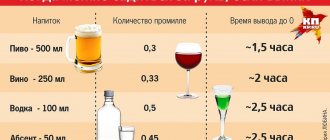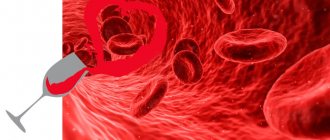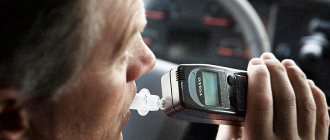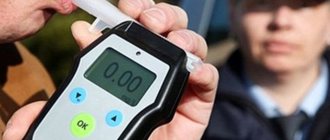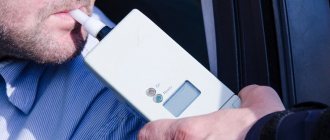Alcohol calculator for drivers is a service that helps determine the level of alcohol in the blood depending on physical indicators, as well as calculate the required time until it is completely eliminated. For you, an alcohol calculator was created exactly according to Widmark's formula with the addition of new indicators. Widmark has the priority of regular research, distribution and elimination of alcohol in the human body. Based on which we created this calculator for you:
Attention! All calculations are carried out for informational purposes only. The results of calculations cannot be confirmed in court or by similar organizations.
The site administration does not bear any responsibility for the use by visitors (guests) of the site and the alcohol calculator in law enforcement and other authorities.
The law is strong, but it's law
Every year the punishment for drunk driving becomes more severe, but this does not stop those who like to drive “under the influence”. News feeds contain daily reports of accidents on the roads involving drunken participants.
According to the Ministry of Internal Affairs, since the beginning of 2021, 8,511 accidents have occurred due to drunk drivers, in which 2,071 people died and 11,734 were injured. But all these tragedies could have been avoided if the perpetrators had carried out a simple calculation before getting behind the wheel on an online alcohol calculator.
The alcohol calculator for drivers most accurately determines the alcohol ppm in the body and forces you to realistically assess your condition and all sorts of risks from the upcoming trip.
The permissible blood alcohol content is 0.16. According to the calculations of the alcohol calculator for online drivers, this is approximately 150 milliliters of beer drunk before the trip for a man weighing 80 kg. This level is determined for the possible error of the breathalyzer. The testimony above is interpreted by traffic police officers as “drunk driving.”
According to current legislation, violators face serious consequences:
- deprivation of driver's license for up to 3 years;
- administrative fine from 30 to 50 thousand rubles.
If there are injuries, the driver bears criminal liability. A repeated violation will result in a fine of up to 200,000 rubles, forced community service, or imprisonment for up to 2 years.
Stages of intoxication
There are 4 degrees of intoxication. The phases of intoxication differ in the amount of ‰ in the blood. The study of each stage allows us to trace the dynamics of the state of a drunken subject.
Less than 0.3
The person behaves normally, but manifestations of alcohol may be hidden. Special tests help establish this.
When intoxicated at less than 0.3 ppm, a person behaves normally.
From 0.3 to 0.5 ppm
A mild stage of intoxication, which develops a few minutes after drinking a strong drink. A person's muscles relax, their mood improves, and a feeling of comfort arises. After a small dose of alcohol, physical activity increases, persistence appears, and the drinker becomes sociable and relaxed.
From 0.5 to 1.5 ppm
A drunken subject is relaxed, does not feel tired or mentally overstrained. Talkativeness and self-confidence appear.
A person craves communication with other people. His coordination of movements is impaired and hesitations occur in his speech.
1.5 to 2.5 ppm
After drinking alcohol in large doses, a person speaks indistinctly, many words cannot be understood. Aggression arises, the mood changes for the worse, and the drunk often takes part in a fight or verbal altercation. He has poor coordination of movements, his gait becomes uneven. After a few hours, the drinker does not remember what events happened to him after drinking strong drinks.
After drinking alcohol in the amount of 1.5 to 2.5 ppm, a person speaks slurred.
2 to 3 ppm
The drunk loses coordination. The gait is unsteady, speech is unintelligible. Loss of consciousness often occurs. A drunk person is unable to control the functions of the bladder and intestines: spontaneous release of urine and bowel movements are often observed.
3 to 5 ppm
An alcoholic is unable to carry on a conversation, cannot walk a few meters, because...
constantly falls to the ground. He does not recognize his relatives and friends, does not remember with whom and when he drank alcohol. As a result of the toxic effects of alcohol, metabolism in the heart muscle changes. A person develops heart and vascular failure. A drunk person suffering from concomitant diseases often falls into a coma. The patient experiences nausea that progresses to vomiting. Aspiration of the respiratory tract may occur due to profuse salivation and repeated reflex eruption of stomach contents.
When intoxicated from 3 to 5 ppm, a person falls.
More than 5 ppm
After consuming a large dose of alcohol, damage to the central nervous system occurs and disorders of the respiratory system appear. A drunk person experiences arrhythmia and tachycardia. A drunk man loses consciousness, does not understand what is happening to him, lies motionless. If the patient is not provided with emergency assistance in time, cardiac arrest occurs. When the amount of alcohol in the blood reaches 5.0-6.0‰, death occurs.
Alcohol calculator for the driver (beginning of the feast)
If there is a feast ahead, and a trip in the morning cannot be avoided, the alcohol calculator for drivers 2018 will help you calculate your drinking rate for the evening, which will allow you to go about your business without fear in the morning.
To calculate, just enter your physical data into the online alcohol calculator. Calculate the time after which you will have to travel, and, knowing what kind of alcohol is planned, you can find out its permissible amount. For example, for the same hypothetical man weighing 80 kg, the alcohol calculator, taking into account the time (6 hours after the feast), allows him to drink 1200 ml of beer (5% strength).
It is worth considering the nature of the drink at the upcoming holiday. If you know the brand and strength, then making an online calculation using an alcohol calculator will not be difficult. You can read about what is better to drink: vodka or beer here.
It’s more difficult if according to plans there will be moonshine or alcohol on the table. In this case, you should first use an alcoholic alcohol dilution calculator or an alcoholic moonshine dilution calculator.
Moonshine
The alcohol calculator will calculate the amount of water to dilute the moonshine to the desired strength. To do this, you need data on the percentage of alcohol in the moonshine itself. Usually, at the distillation stage, a moonshine's alcohol calculator is used to calculate the amount of ingredients. Thanks to these calculations, the strength of the finished product is already known at the output. But if you didn’t use it, you can determine the degree of the drink using an alcohol meter.
Alcohol
The online alcohol calculator also calculates the dilution of alcohol and determines the required amount of water based on the initial strength and the desired result. The strength of the original alcohol is usually 95.6%. That is, per liter of such alcohol you will need 1.39 water to achieve the final 40%.
How many ppm is in a bottle of vodka
This is a controversial and rather floating issue. Let's give an example of a calculation so that everyone can determine how many ppm the blood will contain after a certain amount of drinking.
Vodka is a strong drink. For example, let's take 0.5 liters of vodka. According to statistics, this is the volume of bottles most often purchased. The average weight of a man fluctuates around 80-90 kg. Let's take the mass to be 90 kg. We will carry out a step-by-step calculation.
- In medical calculations, the weight of the liquid is assumed to be 70% of the weight of a man and 60% of the weight of a woman. That is, in our case: 90*0.7=63 kg
- Vodka contains 40% alcohol. That is, 0.5*0.4=0.2 l.
- The density of ethyl alcohol is 0.79 g/cm3. And there are 1000 cm3 in one liter. That is, to convert liters to grams, you need to perform the following calculation: (0.2*1000)*0.79=200*0.79=158 g of alcohol.
- Alcohol contains approximately 10% impurities. That is, from 158 g ethanol will be 158 * 0.9 = 142.2 g = 0.1422 kg
- Now let's calculate ppm as the ratio of ethanol to the total amount of fluid in the body: 0.1422/63=0.0023=2.3 ppm.
That is, after a man weighing 90 kg drinks 0.5 liters of vodka, his blood will contain 2.3 ppm of alcohol. This is approximately 1.15 mg of alcohol per liter of air when released.
This is the maximum value that will be achieved when drinking a bottle of vodka. Immediately after entering the body, alcohol begins to be actively processed. The liver and kidneys will try to remove the poison as quickly as possible. Every hour the number of ppm in the blood will decrease.
Alcohol calculator for the driver (end of the feast)
Alcohol calculator
An alcohol calculator for the driver will also help in that situation when plans suddenly changed, and after the feast it became clear that you would have to get behind the wheel. An online alcohol calculator will help you calculate the exact time you will have to wait. In this case, you need to try to remember what and how much you drank. The accuracy of the calculations depends on this.
But you need to understand that the rate of elimination of ethyl alcohol from the body is influenced by many factors:
- weight,
- floor,
- type of drink (table for removing alcohol from the body);
- physical condition and health,
- frequency of use,
- emotional state (under stress, the body gets rid of alcohol faster),
- individual characteristics.
You can learn more about how long it takes for alcohol to dissipate here.
Even the fastest and most accurate alcohol calculator produces average values, which may differ from the results of a breathalyzer (the same alcohol calculator, but it determines the level of breakdown products of ethyl alcohol in the exhaled air).
A professional forensic alcohol calculator works on the same principle: it calculates your alcohol level by body weight, taking into account the type of drink and the time that has passed.
Alcohol elimination table
For ease of perception, it is worth collecting information on how long it takes for alcohol to disappear from the body in a table.
Let's take a closer look at how long it may take to completely sober up when taking various drinks.
Beer is produced by fermenting malt wort made from barley with the help of yeast and hops. In terms of its effect on the body, a liter of beer is equivalent to 87 ml of vodka. Based on the data in the table, we can say that beer dissipates faster than other alcoholic drinks, however, the rate of blood purification from its breakdown products is affected not only by degree, gender, weight, but also by:
the condition of the internal organs - it is the liver that cleanses the body of toxins; if its functioning is impaired, alcohol is eliminated more slowly.
A man of average build will need at least three to four hours to air out a bottle of beer (0.5 l). If you drink more (a liter of beer), then it will take at least 10 hours to restore attention and full concentration.
A glass (100 ml) of dry red or white wine dissipates within an hour to an hour and a half. The stronger it is and the more calories it contains (white wine has slightly fewer calories), the more time it takes to cope with the alcohols of “fermented grape juice”. It should be borne in mind that after drinking natural wine, alcohol dissipates more intensively than after drinking powdered wine.
On average, as can be seen from the table, a healthy body needs at least 4–5 hours to cope with a glass of vodka (100 ml).
More noble drinks - cognac, brandy, whiskey aged for many years - are excreted 10% slower than vodka due to the tannins they contain. It turns out that after tasting an elite drink you will have to wait at least 5.5–6 hours for the blood to clear.
Alcohol calculator for drivers: when can you start driving?
Depending on the amount of ppm, several degrees of intoxication are distinguished. It can be determined not only after entering data into an alcohol calculator for the driver , but also by objectively assessing the physical condition and reaction speed.
Degrees of intoxication:
| Number of ppm | Stage of intoxication, external signs |
| 0,1-0,29 | Sober state, can only be detected by tests and analyzes |
| 0,3-0,59 | Lung. The person is relaxed, concentration is reduced, excessive talkativeness. As a rule, the alcohol calculator for drivers shows after beer (1000-2000 ml). |
| 0,6-0,9 | Middle stage. Perception of reality is impaired |
| 1-1,9 | Strong. Aggressive behavior, loss of self-control, impaired motor skills. |
| 2-2,9 | Very strong. Loss of consciousness, memory |
| 3-3,9 | Alcohol poisoning. |
| 4-5 | Loss of consciousness, risk of death |
| 5 and above | Lethal dose of alcohol |
An online calculation using an alcohol calculator will help you distinguish the first three degrees of intoxication.
So, if you need to go, and the alcohol intoxication calculator shows an unacceptable amount of ppm, it is worth remembering that there are foods and substances that help the body cleanse itself faster.
Products that accelerate the removal of alcohol from the body
Let’s assume that after a bottle of beer (5%), the alcohol calculator for the 2021 driver shows 0.485 ppm (still the same man weighing 80 kg). Subjectively, a person feels almost sober, however, driving with such indicators is prohibited. In this case, if it is not possible to wait for the natural cleansing of the body, the following products will help:
- cabbage (stimulates the intestines),
- all citrus fruits (vitamin C),
- strawberry,
- garlic (activates liver function),
- bananas (be careful with them, as they contain natural ethyl alcohol, which can briefly increase the readings of the driver’s alcohol calculator),
- grape,
- parsley (detoxifies),
- milk.
- honey.
Medicines
A number of medications that can be found in any home can also help to reduce the indicators of an alcoholic medical calculator.
- sorbents (activated carbon, polysorb). This is what you should take first of all, as soon as you receive the result from the alcohol calculator for the driver. These drugs help remove toxic substances from the body;
- glycine also has an antitoxic effect;
- zorex.
Important: The dosage and method of administration must be determined by a doctor!
Folk remedies
- Mint tincture. Infuse a teaspoon of mint in a glass of vodka for a week. 15-20 drops of this tincture per glass of water is enough for quick sobering. Of course, this option is for especially prudent people. If the need to travel arose unexpectedly, and the online alcohol calculator hints that you cannot travel, other folk remedies will help;
- Ammonia (5-6 drops per glass of water);
- Egg cocktail: a pinch of black and red pepper, a tablespoon of vegetable oil, tomato puree (2 tablespoons) and yolk. Pour in the mixture of vinegar and horseradish, stir. You have to really try to drink this cocktail in one gulp.
Alcohol detoxification
The absorption of ethanol in the liver is accompanied by general intoxication of the body, also called a hangover. This condition is manifested by a deterioration in general health, headaches and muscle pain, vomiting and nausea, dehydration, high blood pressure and rapid heartbeat.
Usually a hangover occurs in the morning, after drinking, and lasts 6-10 hours. To restore water balance, it is useful to drink salty and sour drinks. It is better to limit your food to chicken broth without vegetables, so as not to injure the gastric mucosa.
Removing alcoholic beverages at home
You can help your body fight a hangover on your own, but all measures will not bring quick results. At home, it is useful to take a shower and drink salty fermented milk drinks: kumiss, ayran. Fruit juices and vegetable brines are also useful: cucumber, tomato, cabbage. The latter contain lactic acid, which stimulates the release of alcohol.
WITHDRAWAL FROM BINGE BINGE AT HOME
Alcohol removal tablets
Alcohol elimination tablets are divided into two types: the first contain malic or lactic acid, which promote the breakdown of ethanol (Zorex, Corrda, Antipohmelin, etc.). The latter bind toxins and remove them unchanged (Polysorb, Enterosgel, activated carbon). All of them help to significantly speed up the withdrawal of alcohol. It is also useful to take acetylsalicylic acid, which normalizes temperature, relieves pain and helps thin the blood, relieving stress on the heart.
Rapid elimination with droppers
To quickly get rid of traces of yesterday's fun and restore your performance, it is better to consult a doctor for a medicinal drip. This way, the drugs will immediately enter the bloodstream and quickly spread to all cells. This method allows you to get rid of hangover symptoms in just 1 hour, and you can achieve complete elimination of alcohol within 4-5 hours from the start of the procedure.
Article prepared by an expert
Terekhova Anna Vladimirovna
psychologist-consultant on socio-psychological work with addicted clients and their families. More than 9 years of experience.
Similar articles:
How much does it cost to treat a drug addict?
Opium: what is it, signs of use
What to do if an addict does not want treatment?
How much does drug addiction treatment cost?
The effect of opiates on the body
